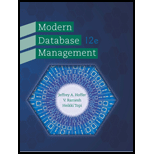
Concept explainers
(a)
Definition of Determinant.
Explanation of Solution
Functional dependency is considered as a relationship between two attributes like in a primary key attribute and other non key attributes. In a functional dependency, the attribute on the left side of the arrow is called as determinant.
(b)
Definition of Functional dependency.
Explanation of Solution
Functional dependency is considered as a relationship between the attributes like in a primary key attribute and other non key attributes. An attribute A is a functional dependent on a primary key attribute B if the value of B uniquely determines the value of A.
(c)
Definition of Transitive Dependency.
Explanation of Solution
Transitive dependency is a functional dependency between the non key attributes and primary key where non-key attributes are dependent on primary key through another non-key attribute.
(d)
Definition of Recursive Foreign Key.
Explanation of Solution
When the primary key values of the some relation are referenced by the foreign key of same relation, that foreign key is called as Recursive foreign key.
(e)
Definition of Normalization.
Explanation of Solution
Normalization is the process that decomposes the anomalies relations to produce well-structured and smaller relations.
(f)
Definition of Composite Key.
Explanation of Solution
Composite key is the combination of more than one attribute forming a primary key that uniquely identifies a record.
(g)
Definition of Relation.
Explanation of Solution
In relational
(h)
Definition of Normal form.
Explanation of Solution
Normal form is the state of a relation that requires certain rules to be satisfied regarding the relationship between the attributes including their functional dependencies.
(i)
Define partial functional dependency
Explanation of Solution
Partial functional dependency is a functional dependency where non-key attributes are dependent on part of the primary key.
(j)
Definition of Enterprise Key.
Explanation of Solution
An Enterprise key is a primary key with unique value across the relations..
(k)
Definition of Surrogate primary key.
Explanation of Solution
Surrogate primary key is the system generated key that does not have any business to uniquely identify a record.
Want to see more full solutions like this?
Chapter 4 Solutions
Modern Database Management (12th Edition)
- For this question you will perform two levels of quicksort on an array containing these numbers: 59 41 61 73 43 57 50 13 96 88 42 77 27 95 32 89 In the first blank, enter the array contents after the top level partition. In the second blank, enter the array contents after one more partition of the left-hand subarray resulting from the first partition. In the third blank, enter the array contents after one more partition of the right-hand subarray resulting from the first partition. Print the numbers with a single space between them. Use the algorithm we covered in class, in which the first element of the subarray is the partition value. Question 1 options: Blank # 1 Blank # 2 Blank # 3arrow_forward1. Transform the E-R diagram into a set of relations. Country_of Agent ID Agent H Holds Is_Reponsible_for Consignment Number $ Value May Contain Consignment Transports Container Destination Ф R Goes Off Container Number Size Vessel Voyage Registry Vessel ID Voyage_ID Tonnagearrow_forwardI want to solve 13.2 using matlab please helparrow_forward
- a) Show a possible trace of the OSPF algorithm for computing the routing table in Router 2 forthis network.b) Show the messages used by RIP to compute routing tables.arrow_forwardusing r language to answer question 4 Question 4: Obtain a 95% standard normal bootstrap confidence interval, a 95% basic bootstrap confidence interval, and a percentile confidence interval for the ρb12 in Question 3.arrow_forwardusing r language to answer question 4. Question 4: Obtain a 95% standard normal bootstrap confidence interval, a 95% basic bootstrap confidence interval, and a percentile confidence interval for the ρb12 in Question 3.arrow_forward
 Database System ConceptsComputer ScienceISBN:9780078022159Author:Abraham Silberschatz Professor, Henry F. Korth, S. SudarshanPublisher:McGraw-Hill Education
Database System ConceptsComputer ScienceISBN:9780078022159Author:Abraham Silberschatz Professor, Henry F. Korth, S. SudarshanPublisher:McGraw-Hill Education Starting Out with Python (4th Edition)Computer ScienceISBN:9780134444321Author:Tony GaddisPublisher:PEARSON
Starting Out with Python (4th Edition)Computer ScienceISBN:9780134444321Author:Tony GaddisPublisher:PEARSON Digital Fundamentals (11th Edition)Computer ScienceISBN:9780132737968Author:Thomas L. FloydPublisher:PEARSON
Digital Fundamentals (11th Edition)Computer ScienceISBN:9780132737968Author:Thomas L. FloydPublisher:PEARSON C How to Program (8th Edition)Computer ScienceISBN:9780133976892Author:Paul J. Deitel, Harvey DeitelPublisher:PEARSON
C How to Program (8th Edition)Computer ScienceISBN:9780133976892Author:Paul J. Deitel, Harvey DeitelPublisher:PEARSON Database Systems: Design, Implementation, & Manag...Computer ScienceISBN:9781337627900Author:Carlos Coronel, Steven MorrisPublisher:Cengage Learning
Database Systems: Design, Implementation, & Manag...Computer ScienceISBN:9781337627900Author:Carlos Coronel, Steven MorrisPublisher:Cengage Learning Programmable Logic ControllersComputer ScienceISBN:9780073373843Author:Frank D. PetruzellaPublisher:McGraw-Hill Education
Programmable Logic ControllersComputer ScienceISBN:9780073373843Author:Frank D. PetruzellaPublisher:McGraw-Hill Education





